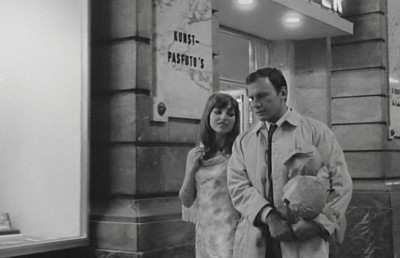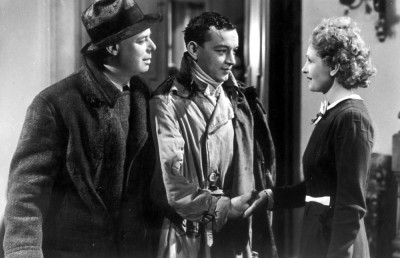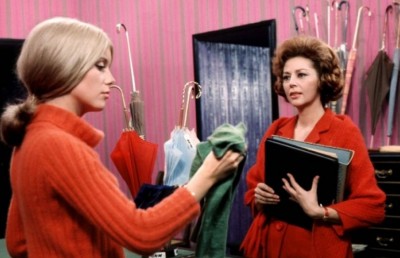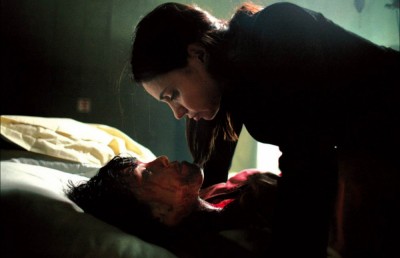The Eye of the Beholder: Marital Discord and Film Making in Jean-Luc Godard’s Le Mepris
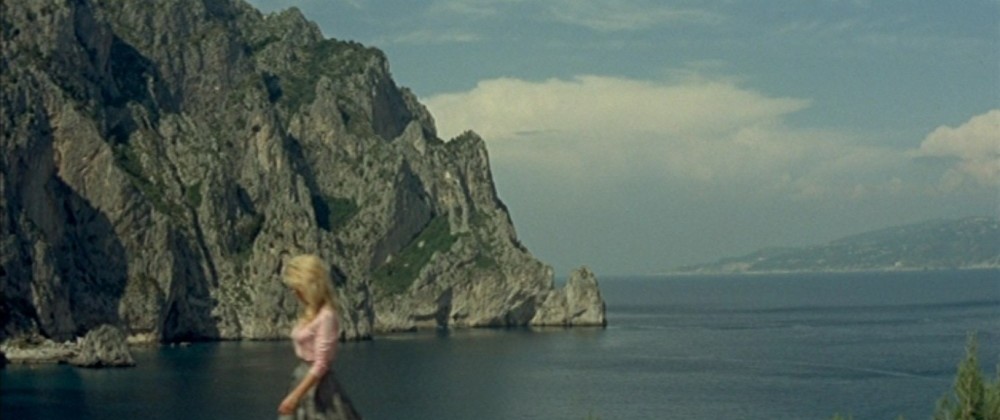
Jean-Luc Godard’s Le Mepris (Contempt, 1963) is routinely cited alongside Francois Truffaut’s La Nuit Américaine (Day For Night, 1973) and Federico Fellini’s 8 ½ (1963) as one of the great European films about film making itself. However, Le Mepris sits uneasily alongside those films. Whereas the Truffaut and Fellini films are almost entirely given over to satirical meditations on the film making process, Godard’s film is first and foremost a portrait of a marriage, with textual reflections on the nature of cinema ultimately existing only so as to suggest the ways in which love, and love of the image, can become detrimentally linked. As Phillip Lopate has observed, Le Mepris “moves us because it is essentially the story of a marriage.” More precisely still, Godard’s film is the story of a film maker’s marriage.
At the time of its release, critical reaction to the film was one of perplexity. Bosley Crowther lamented in the New York Times that for a director who
has as much feeling for the image and as much sense of pictorial style as he[Godard] has, it would seem he could put his talents to more intelligent and illuminating use than he has been doing in his recent pictures – especially Contempt.
Stanley Kauffmann meanwhile suggested that the movie was likely to appeal only to “those interested in Brigitte Bardot’s behind.” [1] To contemporary critics it seemed that Godard had sold out. Perhaps they were prejudiced by the conventional linear narrative – after the staccato story-telling of A Bout de Souffle (Breathless, 1960) and Le Petit Soldat (The Little Soldier, 1963) – at the heart of Le Mepris. Maybe critics found the presence of big-name stars like Brigitte Bardot and Jack Palance, not to mention the money of Joseph E Levine and Carlo Ponti, incongruous in a Godard film. More likely is that when compared to the films that preceded and followed it, Le Mepris simply seemed an anomaly. It is a film that demands an emotional response from its audience more than any other in Godard’s large and varied oeuvre. In classics like A Bout de Souffle and Pierrot le Fou (Pierrot Goes Wild, 1965), Godard continually frustrates the audience’s desire to identify and empathize with the characters portrayed, by using distancing devices such as on-screen titles, surreal episodes, and consciously absurd dialogue. In Le Mepris, while he repeatedly draws attention to the film making process, it never distracts the audience from an emotional response, because the film’s story is really that of Godard, a married film director, making a film about a marriage in breakdown. During production, Raoul Coutard, the film’s cinematographer, told interviewers that “I am convinced that Godard is trying to explain something to his wife in Le Mepris. It’s a sort of letter” (Strick). In this film Godard would draw a direct parallel between the compulsive nature of his creative process and a husband’s (in)ability to interact with his wife. At no other time in Godard’s long career has his obsessive contemplation of cinema, of its nature and the motivation behind its creation, served the story itself so seamlessly, in a perfect melding of form and content.
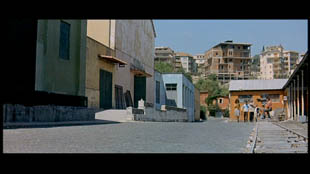
The film opens with a static shot of a film crew shooting a scene. The audience point of view is at the end of a dolly track, the camera filming the scene within this scene moves slowly toward us, filming at right-angle a young woman who also walks in our direction. A voiceover reads the credits of the film and, as the camera comes to the end of the dolly track, reads a purported quote from Andre Bazin, co-founder of the film journal, Cahiers du Cinema, Godard’s critical alma mater: “ ‘The cinema,’ Andre Bazin said, ‘substitutes for our gaze a world that corresponds to our desires.’ Le Mepris is the story of this world.”
As these words are read, the camera in front, and now looming over us, swivels ninety degrees and pans down to zoom directly into our own point of view. The face of the camera operator is as impassive as the Cyclops eye of the lens. Taken together, this shot and accompanying voiceover announce Godard’s intention to examine the role of spectatorship, to investigate the motivations and expectations involved in the act of looking and, by extension, the act of filming. Godard implicates himself in the charge: that to look, and how much more so, to film, far from being a neutral, objective act, is in fact the process of substituting our own preoccupations, expectations, and desires, for reality. It is this theme that lies at the dramatic crux of the narrative.
The film documents in ever more excruciating detail the deteriorating marriage between Paul, a screenwriter in his late thirties, and Camille, a twenty-eight-year-old former typist. Immediately following the opening scene and voiceover, the action cuts to this couple’s bedroom, where they lie in bed, engaging in what is presumably post-coital conversation. Camille lies naked on her front, and takes an inventory of her body parts, asking Paul if he likes each one. To each question he replies in the affirmative, until inventory taken, Camille observes that in that case he must love her totally. Paul replies that he loves her “Totally, tenderly, tragically.” What may at first glance seem a simple scene, is deceptively dense in signification. If the first scene has established the central theme of the movie, then this one demonstrates how that theme will apply to these two characters and their marriage. Paul’s impassioned avowal of love might seem conventionally banal or even melodramatic, but as Camille seeks his opinion of her physique and he indicates his approval, the camera repeatedly pans along her body, slowly back and forth. Camille is played by Brigitte Bardot, that most luxuriantly plastic of visions, and the photography of her in this scene is extravagantly beautiful. It was no doubt prompted by this, that Bosley Crowther and Stanley Kauffmann wrote such dismissive reviews, mistakenly ascribing this preoccupation with her flesh to commercial demands placed on Godard by his producers. The producers did demand an opening scene featuring Le Bardot unclothed, but the camera’s almost obsessive contemplation of her naked form in this scene exists for a very good reason. It self-consciously represents what Laura Mulvey would later call the male gaze. The lingering intimacy of the lens reflects the nature of Paul’s love for his wife, which is defined between them as a love of her physique, exclusively. As Camille lists her constituent body parts from top to toe, and Paul expresses his satisfaction and finally his total love, what is conspicuously never at issue is Camille’s non-corporeal qualities, neither her intellect nor her personality. Camille does not seek his opinion on these facets of her person, nor does Paul require them as part of the equation of his total love. His passionate declaration of love is inspired by the act of contemplating her naked body, irrespective of any other qualities she might possess; by the act of looking, which immediately prompts the viewer to recall the first scene and its implication that to look is essentially to substitute a created world for reality. Nevertheless, there is no implied mockery of Paul in the scene. As the camera delineates Bardot’s contours it is all too easy to understand Paul’s investing her material self with extraneous significance. This process of attribution is suggested by the use of coloured filters in the lighting. As the camera lingers on Bardot, her body is lit in turns by blue and red filters. On first viewing this is easily dismissed as just an aesthetic effect, beautiful undeniably, but meaningless. However, as the film progresses, Godard will establish a rigorous colour coding of the film with the use of bold blues and reds as opposing colours – positive and negative respectively – with yellow denoting neutrality or objectivity. As Paul’s perceptions of people in the film change, so do the colours Godard associates them with. For instance, in the early scenes, when Paul is still confident in Camille’s love, she is dressed all in blue, including a blue headband, but in their flat when she turns on him she significantly appears suddenly swathed in an enormous red bath towel; when Paul twice allows his boss, Prokosch, to drive away with Camille, firstly in a sports car and later in a motorboat, the vehicle is on both occasions red; Francesca, the translator and mediator between the characters, wears the neutral yellow throughout, except in one scene where Paul makes a pass at her at the very moment that she changes into a red sweater. Prokosch uncharacteristically wears a red sweater also, when he drives Camille to Rome and they are both killed in a road accident. Most poignantly, Paul, having belatedly recognized Camille as an independent entity with thoughts and feelings not entirely subordinate to his own, goes to her and finding her sunbathing, tells her, “I feel as if I am seeing you for the first time”; two robes lie beside her, one red and one yellow: when she gets up it is the yellow robe that she puts on, thereby signifying Paul’s newly acquired recognition of her. So, as the coloured filters light Bardot’s body in this early scene, they suggest the ways in which Paul’s appreciation of his wife is influenced – literally coloured – not so much by qualities inherent in her, but rather by his own preconceptions and desires.
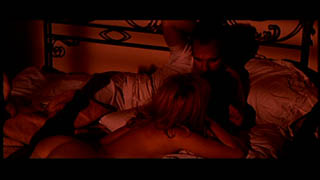
The insubstantial basis for Paul’s nonetheless ardent love of his wife is repeatedly emphasized throughout the film, most superficially through dialogue exchanges between them. That he has no respect for her intellect is established during the key scene set in the couple’s apartment that forms the centre-piece of the narrative. The couple argue, and Paul slaps Camille – now in red – and implores the heavens, “Why did I ever marry a twenty-eight-year-old typist?” Characteristically however, it is when Camille shows signs of exceeding the parameters of nice-dim-blonde that Paul has set for her, that he becomes most uncomfortable. As she models a black bobbed wig for him as a surprise – looking uncannily like Godard’s own wife, Anna Karina – he becomes sullen and tells her that he prefers her blonde. And tellingly, it is while Camille wears this wig, and she is asked by Paul why she looks so thoughtful, that she replies knowingly: “Because I’m thinking, believe it or not.” When she uses bad language, Paul tells her it doesn’t suit her, which irritates her further. She turns to a mirror and recites a litany of swear-words, then turns back to her husband and enquires dryly, “Do you still think it doesn’t suit me?” Most of all, however, the explanation of Paul’s inability to respond to his wife in terms of her larger personality, is located in his attitude to the female form. When, in the second scene Camille offers up her body parts for his delectation, she is implicitly acknowledging how limited his perception of her is. This scene is echoed midway through the film, when Paul leafs through a book of erotic art, and pensively reads aloud a quote from The Odyssey:
I was the judge in a beauty contest between three beauties.
They had chosen me as the judge, and they displayed their wonderful nudity.
The first turned the snowy, dimpled bloom of her back,
The second spread her legs and her flesh glowed rosy red.
The third stood as still as a tranquil sea,
With delicate undulations barely rippling her delicate skin.
Significantly, it is upon reading this passage that Paul calls to Camille in the bathroom that he has decided not to write Prokosch’s script after all, hoping thus to win back her affection. So, it is in the contemplation of female physical perfection that Paul is reminded how important Camille is to him. Later in the same scene, when he thinks back to his early days of happiness with Camille, the images that he recalls are principally naked studies of Camille, definitive examples of the male gaze at work. Again in the same extraordinary scene, Paul casually drums on a bronze statue of a naked woman, rapping it on the breasts and pubis, and remarking that “she sounds different in different places.” The sequence is lightly comic, but especially ironic because for Paul, the female body parts really do almost have the power of expression. Godard never leaves the audience in any doubt that Paul is, as he avowed earlier, “totally, tenderly, tragically” in love with his wife, but the director also stresses that this emotion is entirely a response to her physique. The significance Paul places on the female form is further indicated later in the film, on the boat on which the director, Fritz Lang is filming a nude scene with three actresses. Paul expresses his astonishment that these women can simply be made to undress for the cameras. His self-evident esteem for the naked female is almost reverent. It is for this reason that he is so hurt when, during the apartment scene, upon asking a reproachful Camille if they will continue to have sex together, she throws her towel to one side, rolls onto her belly and says scornfully “Alright, but be quick.” His anguished expression as he covers her with the towel eloquently suggests the solemnity with which Paul responds to his wife’s person. Towards the end of the film, in the aforementioned scene when Paul tries to convince his wife that his attitude toward her has changed, the camera is uncharacteristically shy of her nakedness – she is sunbathing nude – in order to reflect Paul’s growing recognition of Camille as a multifaceted human being rather than an exquisite odalisque. When she finally takes her leave of him, Camille contemptuously throws her robe at him, as if to emphasize what their relationship has consisted of: her nakedness existing for his contemplation. She dives into the sea and swims away, reminding the viewer of the mythical mermaid that Fritz Lang has filmed earlier in the narrative for his production of The Odyssey. Significantly, it is Paul’s last sight of her: naked, mythic, and literally going beyond his reach.
Paul’s attitude to the story of The Odyssey, the script of which he is rewriting for Prokosch, is instructive. He and Prokosch, for the most part so much in competition with one another – for Paul’s wife, for his very artistic integrity – surprisingly share an inclination to interpret the story of Ulysses in psychoanalytical terms. Both men believe that the hero takes so long to return to Ithaca and Penelope because he wishes to test her fidelity, believing her to have been unfaithful in the past. Lang, the film’s director is increasingly frustrated by these modern interpretations of the text. He considers Prokosch a lost cause, but he is moved to take Paul aside at the cinema and gently chide him for his insistence on projecting his own preconceptions on to an autonomous text:
L.: … the beauty in The Odyssey lies precisely in this belief in reality as it is.
P.: Reality as it appears objectively?
L.: Exactly. And in a form not subject to distortion. It is what it is. Take it or leave it.
Godard identifies himself with the character of Paul, through his twinning of Paul’s attitude to Camille with the filmmaker’s urge to film, to “substitute” his own subjective view for reality. Just as Paul transports himself by gazing on his wife’s beauty, so Godard “luxuriates in the sensuality and plasticity” of the film’s Cinemascope images (Guthmann). The director goes further however, in order to associate himself with Paul. Bosley Crowther, in his mocking review scoffed that during the central scene set in the couple’s apartment, “the husband never takes off his hat” despite undressing, bathing and changing clothes. More helpfully, Paul Coates has pointed out in Film Criticism that the headpiece in question is in fact the director’s own porkpie hat, and that Paul’s “cinephilia and sporting of Godard’s own trademark hat” can be seen as part of the process by which the director “alienates himself into the figure of Paul.” According to Phillip Lopate, Godard “considered Paul the first fully developed character he had gotten on film.” And Coutard’s contemporary description of the film as a kind of love-letter from Godard to his wife, gives a further tantalizing clue as to why the director seems so determined to emphasize an alter-ego quality in Paul. Ultimately, of course, the most persuasive evidence is found within the text itself.
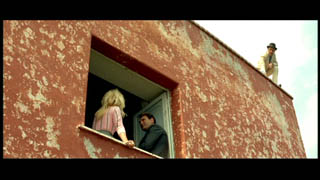
Lopate has argued that other films in Godard’s oeuvre have “more cinematic invention, but in Contempt Godard was able to strike his deepest human chords.” The second part of that statement is undoubtedly true, but the dramatic power of the narrative tends to disguise the formal innovation that underpins it. Godard does nothing less than draw convincing parallels between the act of filming, the process of adaptation of, and engagement with, artistic texts, and the state of marriage, of loving. Furthermore, Paul initially agrees to rewrite his hero, Lang’s script for Prokosch because he thinks that the money gained will secure his and Camille’s apartment and make her happy. He later abandons this stance because he suspects that by compromising his integrity, he has lost his wife’s respect. At the villa on Capri he asks rhetorically: “Why is money so important in what we do, what we are and what we become? Even in our relationships with those whom we love.” While in the very same scene, Lang struggles with Prokosch to get his vision of The Odyssey made in the face of his producer’s market concessions. In this way, Paul’s marital dilemma of material concerns constantly frustrating emotional engagement, is duplicated in the film industry’s conflict between commerce and art. Godard is making a film about a married film maker who is making a film about a marital rapprochement delayed (The Odyssey), who finds that the act of making the film fatally postpones his own attempts at marital reconciliation, and all the while Godard is implicating the very act of looking, of filming, in the inability to successfully engage with a loved one on their own terms. It is this head-spinning self-reflexive audacity that affords the film its extraordinary power.
Le Mepris works as an allegory of the film industry, of art versus commercial homogenisation; as an examination of the act of reading artistic texts; as a forerunner of feminist film theory’s enquiry into the male gaze; but first and foremost as an excoriating portrait of a marriage break-up, possibly the director’s own – Godard and Karina finally divorced in 1967. It is a film about love and cinema – those seeming bed-fellows – that persuasively argues for a caution to be exercised lest the two become incestuously mingled. The character of Paul is a mirror in which Godard regards his attitudes to his wife and to the creative process. And as Jonathan Rosenbaum has argued, that characterisation must finally be considered “as a profound self-critique.” Godard identifies a correlation between his attitude to his wife and his obsession with the cinematic image. For Godard, the image is pregnant with meaning; truth for him is to be found within the celluloid frame – famously at 24 times per second – just as for Paul, Camille’s truth is to be found in her image. This, Godard seems to suggest in Le Mepris, is an attitude ideal for a film director, not so good for a husband and lover.
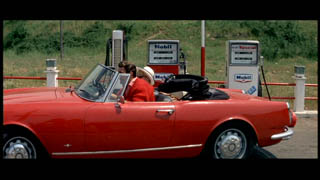
Endnotes
1 Cited by Jonathan Rosenbaum (see bibliography for details).
*Bibliography *
Coates, Paul. ‘Le Mepris: Women, Statues, Gods’, Film Criticism, volume 22, issue 3, 1998.
Crowther, Bosley. New York Times, December 19, 1964.
Guthmann, Edward. San Francisco Chronicle, August 15, 1997.
Lopate, Phillip. Totally, Tenderly, Tragically. (New York: Anchor. 1998.) pp. 50-63.
Mulvey, Laura. “Visual Pleasure and Narrative Cinema,” Screen 16 (3), 1975.
Rosenbaum, Jonathan. “Critical Distance,” Chicago Reader, September 5, 1997.
Strick, Philip. Monthly Film Bulletin, July 1970.


